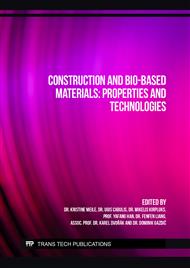[1]
I. Zabalza Bribián, A. Valero Capilla, A. Aranda Usón, Life cycle assessment of building materials: Comparative analysis of energy and environmental impacts and evaluation of the eco-efficiency improvement potential, Build. Environ. Vol. 46(5) (2011), p.1133.
DOI: 10.1016/j.buildenv.2010.12.002
Google Scholar
[2]
L. Ben-Alon, V. Loftness, K. Harries, G. DiPietro, E.C. Hameen, Cradle to site Life Cycle Assessment (LCA) of natural vs conventional building materials: A case study on cob earthen material, Build. Environ. Vol. 160 (2019).
DOI: 10.1016/j.buildenv.2019.05.028
Google Scholar
[3]
E. Christoforou, A. Kylili, P.A. Fokaides, I. Ioannou, Cradle to site Life Cycle Assessment (LCA) of adobe bricks, J. Clean. Prod. Vol. 112 (2016), p.443.
DOI: 10.1016/j.jclepro.2015.09.016
Google Scholar
[4]
S. Marcelino-Sadaba, J. Kinuthia, J. Oti, A. Seco Meneses, Challenges in Life Cycle Assessment (LCA) of stabilised clay-based construction materials, Appl. Clay Sci. 144 (2017), p.121.
DOI: 10.1016/j.clay.2017.05.012
Google Scholar
[5]
P. Melià, G. Ruggieri, S. Sabbadini, G. Dotelli, Environmental impacts of natural and conventional building materials: a case study on earth plasters, J. Clean. Prod. Vol. 80 (2014), p.179.
DOI: 10.1016/j.jclepro.2014.05.073
Google Scholar
[6]
J.E. Oti, J.M. Kinuthia, J. Bai, Engineering properties of unfired clay masonry bricks, Eng. Geo. Vol. 107 (2009), p.130.
DOI: 10.1016/j.enggeo.2009.05.002
Google Scholar
[7]
T. Ashour, A. Korjenic, S. Korjenic, W. Wud, Thermal conductivity of unfired earth bricks reinforced by agricultural wastes with cement and gypsum, Energy Build. Vol. 104 (2015), p.139.
DOI: 10.1016/j.enbuild.2015.07.016
Google Scholar
[8]
P. Muñoz, V. Letelier, L. Muñoz, M.A. Bustamante, Adobe bricks reinforced with paper & pulp wastes improving thermal and mechanical properties, Constr. Build. Mater. Vol. 254 (2020).
DOI: 10.1016/j.conbuildmat.2020.119314
Google Scholar
[9]
M. Giroudon, A. Laborel-Préneron, J.E. Aubert, C. Magniont, Comparison of barley and lavender straws as bioaggregates in earth bricks, Constr. Build. Mater. Vol. 202 (2019), p.254.
DOI: 10.1016/j.conbuildmat.2018.12.126
Google Scholar
[10]
G. Alhaik, V. Dubois, E. Wirquin, A. Leblanc, G. Aouad, Evaluate the influence of starch on earth/hemp or flax straws mixtures properties in presence of superplasticizer, Constr. Build. Mater. Vol. 186 (2018), p.762.
DOI: 10.1016/j.conbuildmat.2018.07.209
Google Scholar
[11]
P. Donkor, E. Obonyo, Earthen construction materials: Assessing the feasibility of improving strength and deformability of compressed earth blocks using polypropylene fibers, Mater. Des. Vol. 83 (2015), p.813.
DOI: 10.1016/j.matdes.2015.06.017
Google Scholar
[12]
C. Dove: WIT Trans. Ecol. Environ. Vol. 142 (2014), p.219. Available online: https://www.witpress.com/Secure/elibrary/papers/ARC14/ARC14020FU1.pdf.
Google Scholar
[13]
C. Galán-Marín, C. Rivera-Gómez, J. Petric, Clay-based composite stabilized with natural polymer and fibre, Constr. Build. Mater. Vol. 24(8) (2010), p.1462.
DOI: 10.1016/j.conbuildmat.2010.01.008
Google Scholar
[14]
I. Chang, A. K. Prasidhi, J. Im, and G.C. Cho, Soil strengthening using thermo-gelation biopolymers, Constr. Build. Mater. Vol. 77 (2015), p.430.
DOI: 10.1016/j.conbuildmat.2014.12.116
Google Scholar
[15]
A. Soldo, M. Miletić, M.L. Auad, Biopolymers as a sustainable solution for the enhancement of soil mechanical properties, Sci. Rep. Vol. 10(1) (2020).
DOI: 10.1038/s41598-019-57135-x
Google Scholar
[16]
Y.I. Cornejo-Ramírez, O. Martínez-Cruz, C.L. Del Toro-Sanchez, F.J. Wong-Corral, J. Borboa-Flores, F.J. Cinco-Moroyoqui, The structural characteristics of starches and their functional properties, CyTA - J. Food Vol. 16 (2018), p.1003.
DOI: 10.1080/19476337.2018.1518343
Google Scholar
[17]
S. Wang, C. Li, L. Copeland, Q. Niu, S. Wang, Starch retrogradation: a comprehensive review, Compr. Rev. Food Sci. Food Saf. Vol. 14 (2015), p.568.
DOI: 10.1111/1541-4337.12143
Google Scholar
[18]
G. Alhaik, M. Ferreira, V. Dubois, E. Wirquin, S. Tilloy, E. Monflier, G. Aouad, Enhance the rheological and mechanical properties of clayey materials by adding starches, Constr. Build. Mater. Vol. 139 (2017), p.602.
DOI: 10.1016/j.conbuildmat.2016.11.130
Google Scholar



